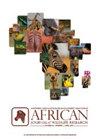南非野生小鹿(Dama Dama)的胴体组成和产量
IF 1
4区 环境科学与生态学
Q2 Agricultural and Biological Sciences
引用次数: 4
摘要
尽管南非有大量的野生黇鹿(Dama Dama),但它们作为一种潜在的蛋白质来源仍然被忽视,人们对它们的胴体生产潜力知之甚少。我们的研究旨在确定在南非收获的休鹿的胴体特征、肉产量和内脏贡献,以及性别对其的影响。雄休鹿(n = 8)的屠宰重、热胴体重和冷胴体重高于母休鹿(n = 14),怀孕母休鹿(n = 5)的屠宰重高于未怀孕母休鹿(n = 9)。同样,雄休鹿的屠宰率(62%)高于母休鹿(59%),但与其他非洲野生动物和家畜的屠宰率相当或超过。消耗性内脏(不含胃和肠)分别占公母肉鸡屠宰重的10%和9%,对某些内脏成分有显著的性别和妊娠影响。7块肌肉(胸腰最长肌、冈下肌、冈上肌、股二头肌、半膜肌、半腱肌、大腰肌)的个体重量在男女之间没有差异。然而,雄鹿的总肉重和骨重显著高于雌鹿,尽管雄鹿和雌鹿的肉骨比没有差异。这些基线数据应为南非野味肉类工业增加对黇鹿的利用提供动力,并加强这些动物对国内粮食安全的贡献。本文章由计算机程序翻译,如有差异,请以英文原文为准。
Carcass Composition and Yields of Wild Fallow Deer (Dama dama) in South Africa
Although wild fallow deer (Dama dama) are abundant in South Africa, they remain overlooked as a potential protein source and little is known about their carcass production potential. Our study aimed to determine the carcass characteristics, meat yields and offal contributions of fallow deer harvested in South Africa, as well as the effect of sex thereupon. Slaughter weights, warm carcass weights and cold carcass weights were higher in male (n = 8) fallow deer versus females (n = 14), and in pregnant females (n = 5) compared to non-pregnant females (n = 9). Similarly, dressing percentages were higher in males (62%) than females (59%), but were comparable to, or surpassed, those of other African game species and domestic livestock. Consumable offal (excluding stomach and intestines) contributed 10% and 9% to the slaughter weights of males and females, respectively, with some significant sex and pregnancy effects on certain offal components. The individual weights of seven muscles (longissimus thoracis et lumborum, infraspinatus, supraspinatus, biceps femoris, semimembranosus, semitendinosus, psoas major) did not differ between males and females. However, male fallow deer had significantly higher total meat and bone weights than females even though no differences were observed for the meat-to-bone ratios between males and females. These baseline data should provide the impetus for increased utilization of fallow deer by the South African game meat industry and strengthen the contribution of these animals to domestic food security.
求助全文
通过发布文献求助,成功后即可免费获取论文全文。
去求助
来源期刊

African Journal of Wildlife Research
Multiple-
自引率
0.00%
发文量
14
期刊介绍:
The African Journal of Wildlife Research is an ISI ranked, leading peer reviewed scientific publication in wildlife research in Africa, Arabia and Madagascar, with a broad base covering scientific, applied, managerial, methodological and sociological issues related to wildlife research. The journal publishes original full-length scientific papers, short communications, book reviews as well as reviews on science-based research invited by the editor-in-chief. This research journal and has been published annually since 1971.
Until 2014 (Volume 44) the journal was known as the South African Journal of Wildlife Research and from 2015 (volume 45) the name changed to African Journal of Wildlife Research. The journal reaches a wide readership, including both local and foreign wildlife managers, academics and wildlife owners, and libraries local and abroad. It is an important reference for anyone interested in the management and sustainable utilisation of natural resources.
 求助内容:
求助内容: 应助结果提醒方式:
应助结果提醒方式:


